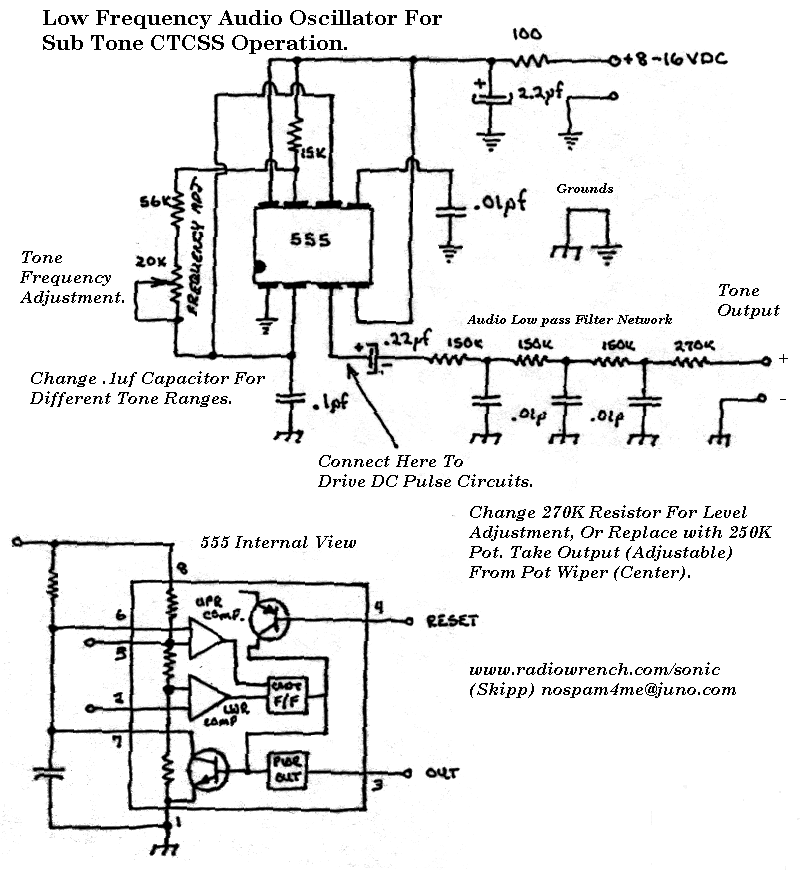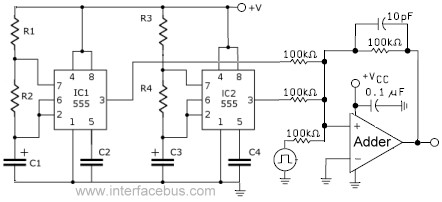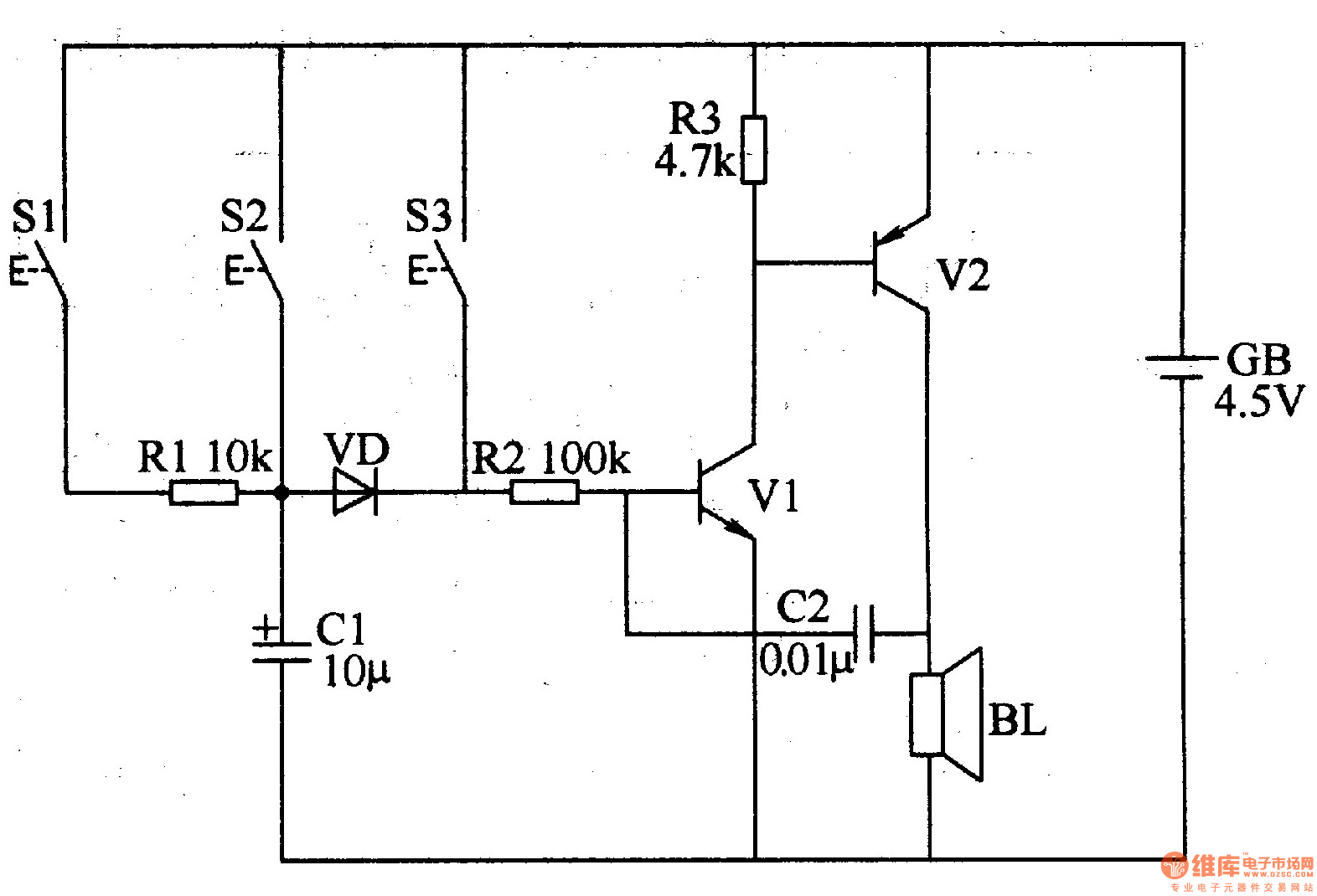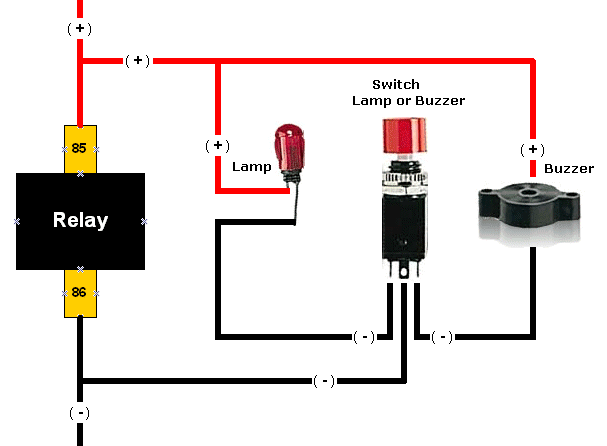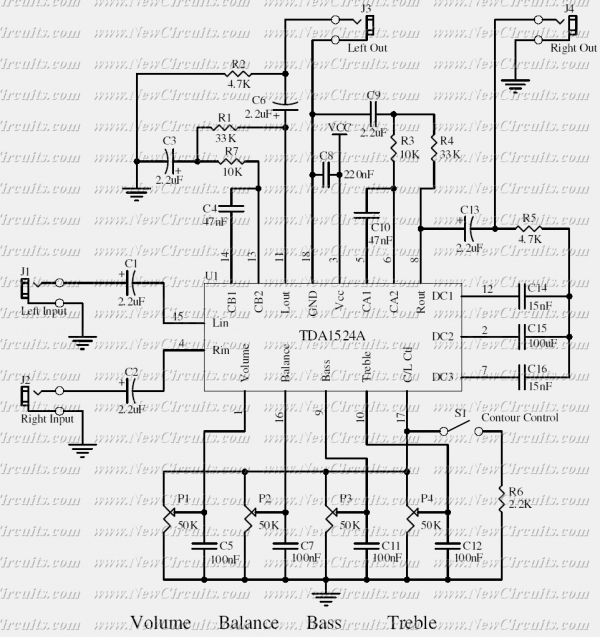
Tone ControlCircuit
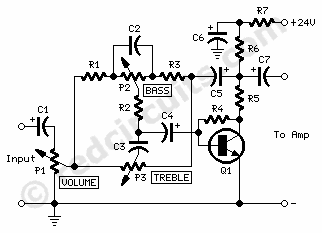
P1 47K logarithmic potentiometer; P2, P3 47K linear potentiometers; R1, R3, R5 4.7K 1/4W resistors; R2 22K 1/4W resistor; R4 1M 1/4W resistor; R6 1.8K 1/4W resistor; R7 560Ω 1/4W resistor; C1, C4, C5, C7 10 µF 63V electrolytic capacitors; C2 47nF 63V polyester capacitor; C3 1nF 63V polyester capacitor; C6 220 µF 35V electrolytic capacitor; Q1 BC550 45V 100mA NPN low noise high gain NPN transistor. A bass and treble frequency control circuit is designed for a 3-5W Class-A amplifier, focusing on simplicity and minimal component usage. Q1 serves as the sole active component, forming a single-stage transistor amplifier with a tone control network in the AC feedback path. The feedback from the split load of Q1 yields an AC stage gain of approximately 3, suitable for handling low output voltage audio sources.
The circuit design incorporates a logarithmic potentiometer (P1) for volume control, allowing for a more natural adjustment of audio levels, particularly important in audio applications. The linear potentiometers (P2, P3) are utilized for bass and treble adjustments, enabling users to tailor the audio output to their preferences. The resistors (R1, R2, R3, R4, R5, R6, R7) are strategically selected to set the gain, biasing conditions, and feedback levels, ensuring stable operation of the transistor (Q1).
Capacitors (C1, C2, C3, C4, C5, C6, C7) are chosen to filter and couple the audio signals, with electrolytic capacitors providing necessary bulk capacitance for power supply decoupling and polyester capacitors ensuring signal integrity in the frequency response. The use of a BC550 transistor as the sole active component allows for a low-noise amplification stage, which is critical for high-fidelity audio applications.
The overall architecture of the circuit maintains a balance between performance and simplicity, making it suitable for integration with low-output audio sources. The AC feedback mechanism not only stabilizes the gain but also contributes to the overall tonal quality of the amplifier, providing a user-friendly interface for enhancing audio playback. This design approach is particularly appreciated by audio enthusiasts seeking to optimize their listening experience with minimal electronic complexity.P1_47K Log. Potentiometer (See Notes) P2, P3_47K Linear Potentiometers R1, R3, R5_4K7 1/4W Resistors R2_22K 1/4W Resistor R4_1M 1/4W Resistor R6_1K8 1/4W Resistor R7_560R 1/4W Resistor C1, C4, C5, C7_10 µF 63V Electrolytic Capacitors (See Notes) C2_47nF 63V Polyester Capacitor C3_1nF 63V Polyester Capacitor (See Notes) C6_220 µF 35V Electrolytic Capacit or Q1_BC550 45V 100mA NPN Low noise High gain NPN Transistor A Bass and Treble frequency control to be added to the 3 - 5W Class-A Amplifier was required by some audio enthusiasts. Therefore, this circuit has been designed keeping in mind the extreme simplicity of the amplifier circuit to which it should be linked and was carried out using as few as components possible.
Q1 is the only active component forming a straightforward single-stage transistor amplifier with the tone control network in the ac feedback path. Taking this feedback from the split load of Q1 we obtain an ac stage gain of about 3: this can be useful to cope with low output voltage audio sources.
🔗 External reference
The circuit design incorporates a logarithmic potentiometer (P1) for volume control, allowing for a more natural adjustment of audio levels, particularly important in audio applications. The linear potentiometers (P2, P3) are utilized for bass and treble adjustments, enabling users to tailor the audio output to their preferences. The resistors (R1, R2, R3, R4, R5, R6, R7) are strategically selected to set the gain, biasing conditions, and feedback levels, ensuring stable operation of the transistor (Q1).
Capacitors (C1, C2, C3, C4, C5, C6, C7) are chosen to filter and couple the audio signals, with electrolytic capacitors providing necessary bulk capacitance for power supply decoupling and polyester capacitors ensuring signal integrity in the frequency response. The use of a BC550 transistor as the sole active component allows for a low-noise amplification stage, which is critical for high-fidelity audio applications.
The overall architecture of the circuit maintains a balance between performance and simplicity, making it suitable for integration with low-output audio sources. The AC feedback mechanism not only stabilizes the gain but also contributes to the overall tonal quality of the amplifier, providing a user-friendly interface for enhancing audio playback. This design approach is particularly appreciated by audio enthusiasts seeking to optimize their listening experience with minimal electronic complexity.P1_47K Log. Potentiometer (See Notes) P2, P3_47K Linear Potentiometers R1, R3, R5_4K7 1/4W Resistors R2_22K 1/4W Resistor R4_1M 1/4W Resistor R6_1K8 1/4W Resistor R7_560R 1/4W Resistor C1, C4, C5, C7_10 µF 63V Electrolytic Capacitors (See Notes) C2_47nF 63V Polyester Capacitor C3_1nF 63V Polyester Capacitor (See Notes) C6_220 µF 35V Electrolytic Capacit or Q1_BC550 45V 100mA NPN Low noise High gain NPN Transistor A Bass and Treble frequency control to be added to the 3 - 5W Class-A Amplifier was required by some audio enthusiasts. Therefore, this circuit has been designed keeping in mind the extreme simplicity of the amplifier circuit to which it should be linked and was carried out using as few as components possible.
Q1 is the only active component forming a straightforward single-stage transistor amplifier with the tone control network in the ac feedback path. Taking this feedback from the split load of Q1 we obtain an ac stage gain of about 3: this can be useful to cope with low output voltage audio sources.
🔗 External reference
